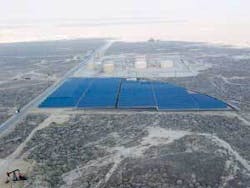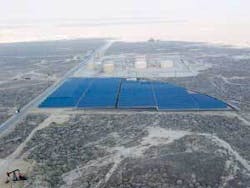SPECIAL REPORT: Solar energy powers production of heavy oil in California
A 500-kw solar photovoltaic project, Solarmine, provides daytime electricity to Chevron Corp.’s part of Midway-Sunset heavy oil field in California’s San Joaquin Valley.
Chevron is among the largest landowners of numerous companies operating in the field, which produces 13° gravity oil. California statistics indicate the field produced 84.5 million bbl of oil and condensate and 3.3 bcf of natural gas during 2005.
Solarmine is a collaboration of Chevron and an Energy Conversion Devices Inc. (ECD) subsidiary, United Solar Systems Corp. (Uni-Solar). Uni-Solar manufactured the solar panels. Chevron owns 20% of ECD. Texaco Technology Ventures initiated Solarmine before Texaco merged with Chevron.
An array of 4,800 amorphous-silicon solar panels, each about 1.3 ft by 18 ft, are mounted on metal frames facing south. The panels are arranged into 400 strings with each string having 12 panel modules. The array area covers 2.8 acres, and the entire Solarmine complex covers 6 acres.
The project cost, excluding the land, was $4.86 million. Chevron recouped half of that expense with a $2.43 million rebate through its participation in the California Energy Commission Emerging Renewable Buydown Program.
Solarmine, operating since late 2002, has no battery backup or storage. It automatically connects with the local electricity grid at sundown and disconnects at sunrise. The panels begin putting out 80 kw at sunrise and reach a 500-kw peak around midday.
On cloudy days when Solarmine puts out less power, other cogeneration power systems make up the difference and provide sufficient power for field operations.
Inside a Solarmine conversion building, an inverter and an isolation transformer convert direct current from the solar modules to alternating current and step it up to 12,000 v for the field’s power grid.
An automated tracking system provides real-time data to evaluate Solarmine’s performance. Company statistics indicate that 2003 operations saved $83,000 in electricity costs at 6.3¢/kw-hr. The solar energy also was estimated to have avoided 850 tonnes of CO2 emissions and 1,950 lb of nitrogen oxide emissions during 2003.
Chevron Energy Solutions
Chevron’s energy services subsidiary, Chevron Energy Solutions, helped design and install Solarmine. CES projects often are bundled with renewable or alternative power such as solar systems or fuel cells.
CES Senior Vice-Pres. David L. Stone said energy efficiency and reliability are important to Chevron because energy is one of the biggest expenses in oil and gas operations.
“Chevron has achieved a 27% improvement in energy efficiency since 1992 to present,” Stone said. “That is about $1 billion/year out of our average cost structure. We lowered energy costs through energy efficiency.”
CES works on upstream, downstream, and midstream projects for Chevron and other clients. Customers include federal government agencies, universities, and others.
“We design and build projects, both energy-efficiency and renewable-power projects, for customers as well as for our own facilities,” Stone said. “To our knowledge, none of the other oil and gas companies have a business that looks like Chevron Energy Solutions.”
CES estimates that in 2005 it saved its customers more than 177 kw-hr of electricity and 1.185 tcf of natural gas, equivalent to avoiding 97,000 tonnes of CO2 emissions.
Stone said CES is technology-neutral and product-neutral because it does not have any of its own proprietary technology or equipment that it’s trying to sell.
“We are familiar with all state-of-the-art best technologies, whether it is alternative energy, renewable power, or energy efficiency. We will apply what is the very best thing to meet the customer’s need,” Stone said.

